Automation and data analytics have become a part of marketing operations.
As more companies jump into it, the need to adapt to the changing landscape to remain profitable is increasing.
Apart from making profits, companies also need marketing data analytics to improve the consumer experience. By focusing on consumer-centric data, SMEs and corporations can gain a competitive advantage by predicting market changes.
But how can your company predict the future of data analytics in marketing?
Continue reading to discover the current state of marketing data analytics, why and how your company needs to prepare for the future.
The Current State of Marketing Data Analytics
Before discussing the future of marketing data analytics, let’s quickly explore the status quo.
According to Ascend2, 46% of brands rely on data analytics to boost customer loyalty to their brand. The same research shows that 43% of these brands gear their data management efforts toward conversions.
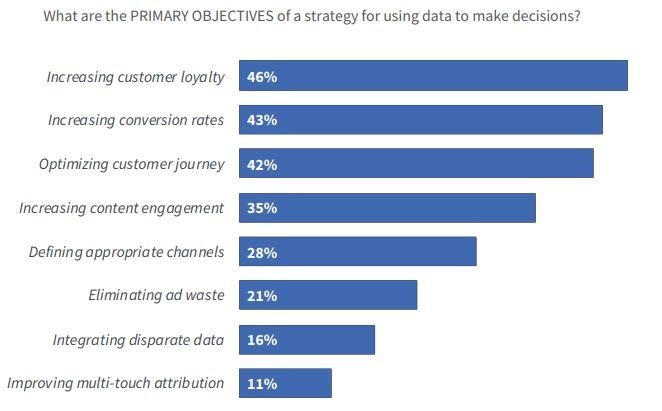
However, data from Gartner highlights marketing leaders’ dissatisfaction with the success of their current strategies. Over 50% of senior marketing executives believe that their data analytics effort hasn’t produced the expected impact.
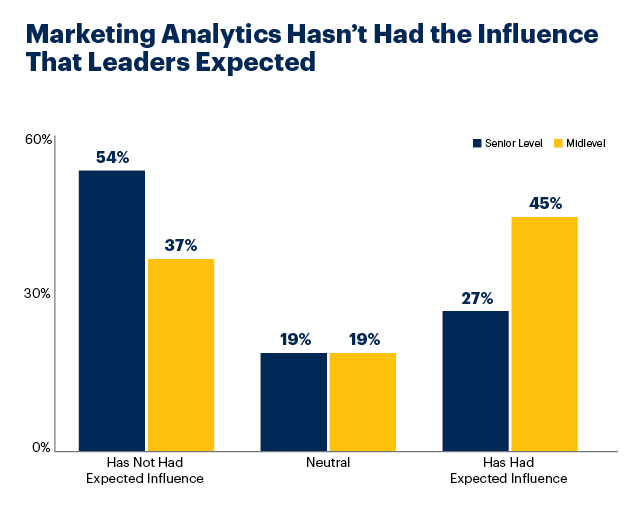
Following the Gartner study mentioned above, businesses also report that their data findings often conflict with their objectives.
Around 44% of them attribute this lack of consistency to poor data quality, while a further 43% believe that their data findings can’t predict a clear pathway to success.
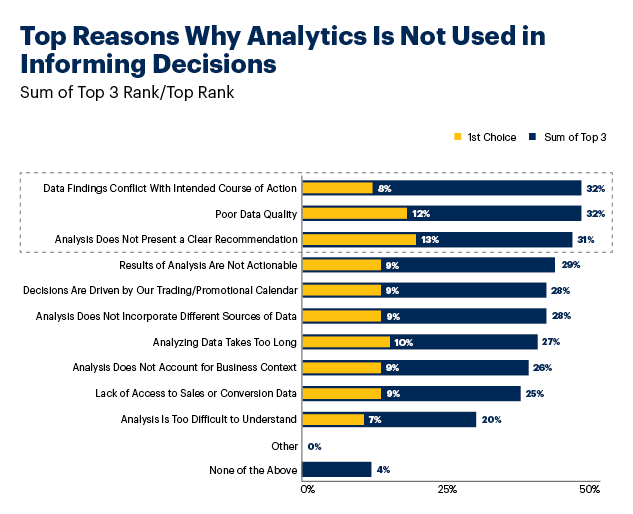
Hubspot also estimates that only 60% of marketers use customer relationship management software, with 82% of them focusing primarily on customer retention.
The same Hubspot report shows that only 57% of companies shifted to hybrid marketing models in 2021. Although the adoption pace has increased as the pandemic lingers, most companies remain reluctant to pivot from their established marketing frameworks.
In terms of social media marketing, most sales and marketing experts credit Facebook and Google search for their increase in sales. And most significantly, 76% of companies use automation in data analytics marketing, while only 46% use AI-empowered solutions.
Essentially, the current state of digital marketing data analytics leaves room for companies to improve customer experience and boost business productivity.
What Does the Future Hold for Marketing Data Analytics?
Predicting the future of marketing data and analytics using a crystal ball has become tougher, especially in this era of unprecedented socio-economic changes.
But through extensive analysis of consumer behavior and emerging industry patterns, we’ve gathered enough intel to figure out what’s next in data analytics. Let’s explore.
1. Wider Adoption of Automation
According to Email Monday, 25% of companies don’t use any form of automation to gather and analyze marketing data. Overall, only 51% have completely automated their business operations.
But as artificial intelligence and machine learning tools become readily available for data management, companies can adopt them to obtain valuable insights. Companies will also implement workflow automation tools to iron out bottlenecks and remove redundancies in the workflow.
Automated chatbots have also helped companies reduce support expenses by 30%, which will accrue 7.3 million USD in savings by 2023.
2. More Focus on Social Media Channels
Since Millenials and Gen Z have more online consuming power than the rest, companies will focus more on social media marketing to tap into this consumer pool.
Social media channels like Facebook, Instagram, and TikTok have made it easy for creators and marketers to monetize their content online.
Judging from TikTok’s 700% CGAR increase in 2021, this social media platform is set to become the go-to for advanced data analytics. Live shopping on social media will also grow exponentially in the coming years.
3. Emphasis on First-party Data
Consumers worldwide have continuously raised privacy concerns about Google and other data-mining companies. In response, Google has proposed a crackdown on third-party cookies that will take effect in 2023.
This move leaves companies with the solitary option of obtaining first-party data – obtained from tracking customers’ browsing patterns and actions on a website.
By analyzing this data, marketers can get actionable insights for product placement and future marketing campaigns. But without AI and deep learning algorithms, marketing executives will struggle to interpret this data.
4. Better Customer Engagement and Retention
Companies that combine automation with advanced data analysis will improve customer satisfaction going forward, whether in customer service or targeted marketing.
As the marketplace gets saturated with new products daily, consumers no longer feel the need to stay loyal to brands. Today, 32% of consumers will abandon their favorite brand after one bad experience.
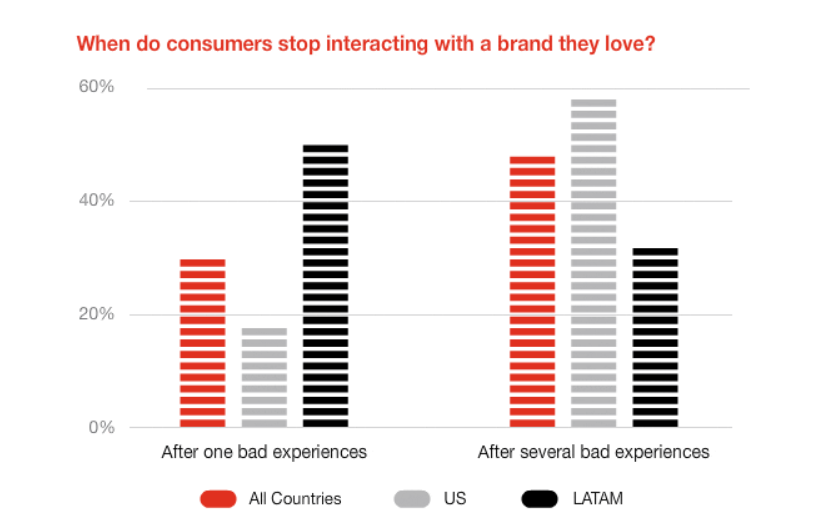
As a result, companies will invest more to boost customer retention and engagement across the board.
5. Accurate Real-time Data Reporting
Getting a competitive advantage with marketing data and analytics depends on your company’s ability to adjust your strategy as fast as possible. To this end, businesses are investing in real-time analysis and reporting tools to make informed decisions faster.
Companies like Amazon and Google have fostered data-driven workflows and sales funnels by using cloud integrations to analyze and report data.
To implement real-time data management, your company can use a change data capture (CDC) protocol to update the database and make real-time changes.
6. Better Real-world Experience
In the past, customer experience focused on improving engagement metrics through A/B testing. But with larger swathes of data available, marketers will focus more on real-world experience moving forward.
Following Facebook’s interest in the Metaverse, more companies will invest in VR and AR marketing strategies. Currently, only 25% of enterprises use these technologies to “augment” the user experience. This number will increase as the Metaverse becomes more popular.
7. Effective Implementation of Data Findings
Gathering information without any practical implementation is a thing of the past. Nowadays, companies are exploring ways to convert all or most of their data into returns on investment.
Let’s explore various forms of data analytics in marketing to understand future implementations of data findings better.
- Descriptive analytics allows you to interpret historical datasets. Soon, you can use data from descriptive analysis to plan campaigns. And with customer journeys becoming more personalized, this intel will help you spot problematic touchpoints in the sales funnel.
- Prescriptive analytics allows you to analyze problem areas in the marketing pipeline to recommend changes for further improvements. Going forward, companies will adopt AI, ML, and deep learning algorithms to test and prescribe the best path to business success.
- Predictive analytics enables you to stay ahead of the competition at every stage. With real-time insights combined with historical data, your company can predict market changes. Although companies like Amazon, Netflix, and YouTube have been using predictive analytics, more SMEs will adopt this model to recommend content and predict buyer behavior.
8. Value-based Lead Scoring Models
In the past, companies used quantitative lead scoring models to drive marketing strategies – every lead counts, regardless of value to the business. But this scoring system makes it challenging to differentiate top-value leads from the available pool.
Going forward, companies will adopt value-based scoring to determine leads with the highest significance to the business.
With AI-powered customer retention management tools, your company can segment consumers based on their value to the business. You will also be able to use machine learning algorithms for more accurate predictive lead scoring.
9. Investment in Robust Data Networks
The success of your business, whether small or massive, will depend on the amount of data available at your disposal.
Instead of relying on isolated databases, companies would have to use integrations to improve business efficiency.
Besides, expanding your data network gives you access to up-to-date marketing data analytics. Even if you are a small business or startup, this amount of actionable data can help you compete against massive companies.
What Do Marketers Need to Prioritize?
Prioritizing some datasets over others is always a headache for marketers when working with a large pool of raw data.
In the past, experts focused on certain conversion metrics for their specific businesses. But since numerous data reporting tools are available today, you have more freedom to explore.
Here are the core insights to focus on moving forward.
Customer Data
Your company should always focus on customer data in marketing because it helps you create relevant segmented lists. Some examples include:
- Identity data: name, mailing address, social media, and phone number.
- Descriptive data: occupation, lifestyle, and education.
- Quantitative data: the number of activities they perform on your website or platform.
- Qualitative data: the customer’s satisfaction with your product.
Transaction Data
You must also focus on transaction-related data to better understand your consumer’s spending habits. Track these metrics:
- Conversion Rate Optimization
- Form Conversion Rate
- Cost Per Lead
Mobile and Website Data
According to Statista, it’s projected that by 2028, the count of smartphone users will reach 5.1 billion, representing 90% of the global population. Also, 51% of internet users browse on their phones, compared to 46% of desktop users.
As the trend continues to shift towards mobile browsing, here are the mobile marketing metrics to monitor:
- Mobile Conversions
- Mobile Search
- Social metrics
Most of your traffic and data source will come from your website: mobile or desktop. Here are the vital website metrics.
- Organic Traffic
- Paid Traffic
- Session Length
- Page Views
- Traffic by Source
- Exit Rate
- Most Visited Pages
- Cost Per Click
- Social Engagement
Struggling to monitor social media metrics across various platforms and convey the results to stakeholders?
Use SocialPIlot’s all-in-one analytics feature to view the metrics of multiple social media platforms under one dashboard. You can also stitch together the analytics of multiple platforms in a single PDF report and share it with your stakeholders to give a complete rundown of the progress.
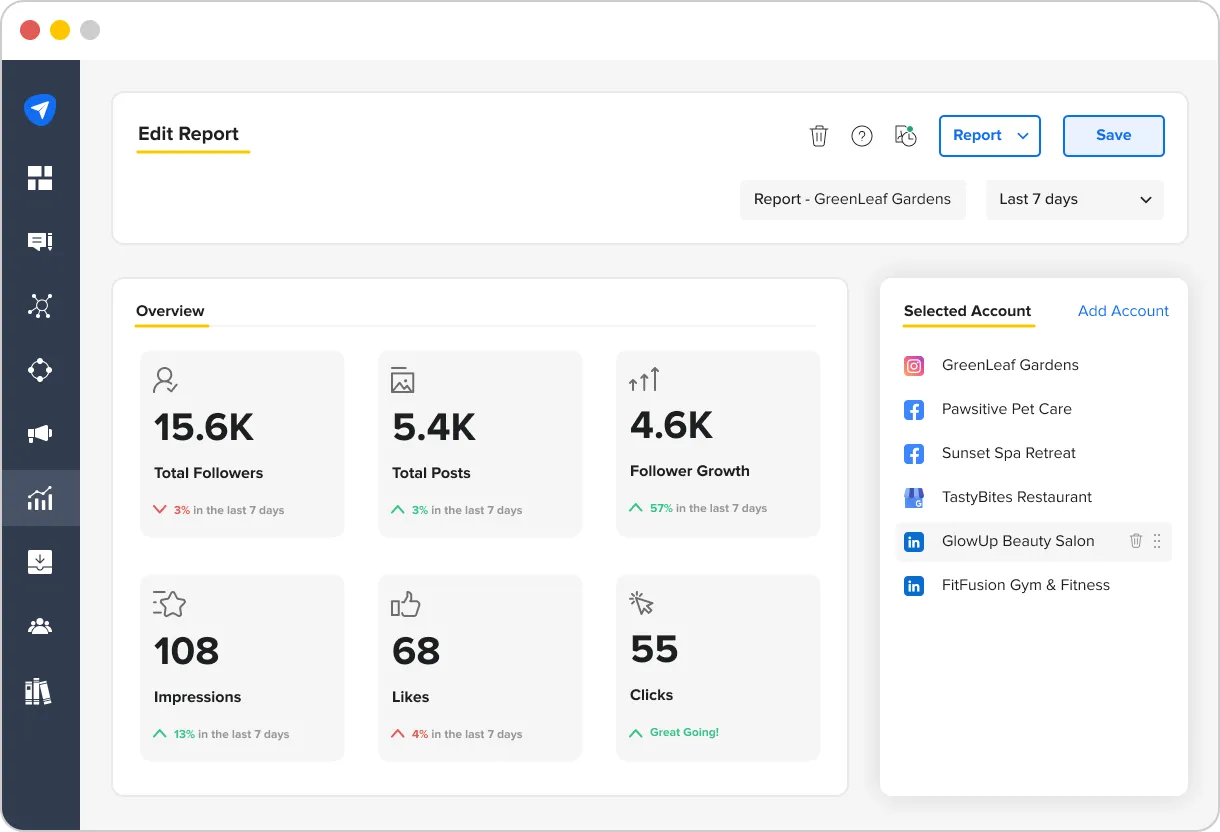
Call Intelligence Data
Companies that interact with users also need to gather data from their customer support desks. The following metrics will help you improve the quality of your company’s customer service:
- Call Abandonment Rate
- Handling Time
- Agent Service Level
- Speed of Answer
- After Call Work Time
- Time in Queue
- Percentage of Calls Blocked
Final Words
Embracing marketing data analytics will give your company a competitive advantage and set up your marketing strategies for the future. By adopting automation, you can improve data reporting accuracy across all business processes.
Focus on social media and mobile marketing to gather data from Gen Z and Millenials. Use AI-powered CRM platforms for advanced data analytics in marketing. And above all, track the relevant metrics for data analytics marketing focused on consumers.
And don’t forget to track your social media marketing performance with the help of a robust tool such as SocialPilot that will assist you in automating your posts, assess their performance through detailed analytics and reports. And a lot more!
Experience it yourself. Try it for free to know more.



